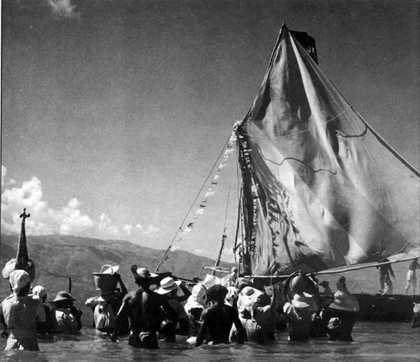The influence of visual anthropology on cinema and the visual arts is explored in this screening and discussion.
These two influential films investigate different approaches and methodologies that propose complex models for the relationship of filmmaker to their subject. We move from the work produced posthumously out of Maya Deren’s footage of dance and possession in Haitian Vodou, to Al Clah’s Intrepid shadows, a remarkable film from the series Navajos film themselves.
This screening will be accompanied by an illustrated talk on the two works by curator Anselm Franke, Head of Visual Arts and Film Department, Haus der Kulturen der Welt, Berlin
Divine horsemen: the living Gods of Haiti
Maya Deren and Teji Ito, USA, 1985, 16mm, black and white, 54 min
Conceived of as a ‘film-poem’ Divine horsemen is a black and white documentary film about dance and possession in Haitian Vodou from material Deren’s recorded during extensive research trips between 1947 and 1954. Most of the film consists of images of dancing and bodies in motion during rituals in Rada and Petro services. Twenty years after Deren's death, the film was completed by Deren's third husband Teji Ito.
Intrepid shadows
Al Clah, USA, 1966–69, 16mm, black and white, 15 min
In 1966 Sol Worth and John Adair conducted an experiment with residents of the Navajo Nation in Pine Springs, Arizona 'to determine whether it is possible to teach people with a technically simple culture to make motion pictures depicting their culture and themselves as they see fit'. Participants received a salary and were instructed in the use of Belland Howell Filmo 16mm camera and basic editing techniques.
The series of seven short documentaries were originally distributed through Columbia University and later through MoMA, at which point Intrepid shadows became known on the art film circuit, leading to Margaret Mead to celebrate the film as 'one of the finest examples of animism shown on film'. Unlike the other films in the series, Intrepid shadows deals with subjective aspects of Navajo life, attempting to reconcile the western notion of God with his traditional Navajo notion of gods.

